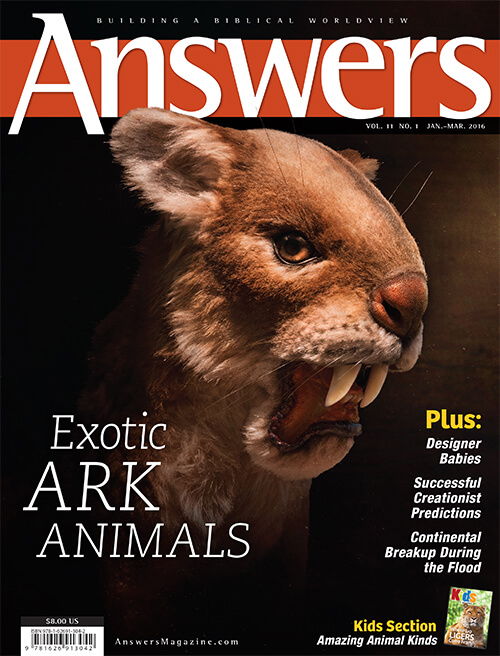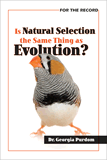
The Proper Place for Natural Selection
Creation Basics
When Charles Darwin studied finches from the Galápagos Islands, he attributed their variations to natural selection. Is there any truth to his claims?
In 2011 I was given the amazing opportunity to travel with a group of homeschool students to the Galápagos Islands. For a biologist, going to the Galápagos is a dream come true! These pristine islands, 600 miles (966 km) off the coast of Ecuador, are home to many unique animals that have very little fear of man. This allowed me to get closer to wildlife than in most other places on the planet. Although I had never photographed animals in the wild before (unless you count pictures I’ve taken of my pets outside!), I was able to get some great photos on Galápagos. The animals seemed almost to pose for my camera.
Darwin’s Laboratory
Mention the Galápagos Islands, and most people immediately think of Charles Darwin. Darwin was a young naturalist when he visited the islands aboard the Beagle in the early 1800s. What he observed there helped him develop the concept of natural selection. Darwin traveled around the islands for several weeks taking notes and collecting specimens, especially birds. Darwin noted that many different species of finches and tortoises lived on only one or a few islands. He interpreted these observations to mean that those species had developed their unique traits there, adapting to the specific conditions on each island, rather than arriving in their current form from somewhere else.
Darwin was correct about one thing. He observed in the present the results of variation and speciation within a created “kind” of animal (for example, multiple species of finches). Unfortunately, he extrapolated the changes he observed in the present to the unobservable past. He developed the idea that given enough time natural selection would cause one kind of animal to evolve into a completely different kind of animal (for example, dinosaurs could evolve into birds).
In one of his notebooks Darwin stated, “Let a pair be introduced [to an area] and increase slowly, from many enemies, so as often to intermarry; who will dare say what result? According to this view, animals on separate islands ought to become different if kept long enough apart, with slightly differ[ent] circumstances.”
Just a few pages later, Darwin drew his historic branching diagram showing how different species might be linked to each other by common descent. This diagram was a visual representation of molecules-to-man evolution. Clearly Darwin did not base his understanding of biology on the biblical account of creation. As a result, he drew wrong conclusions about the unobserved past.
We know from the Genesis account of creation that God spoke animals into existence “according to their kinds.” The inference is that they were supposed to reproduce according to their kinds. Certainly natural selection (as well as other mechanisms) can result in variation and speciation within a kind (what Darwin actually observed). But it cannot cause one organism to evolve into a completely different kind of organism (what Darwin did not observe).
Darwin’s Finches
One type of bird that caught Darwin’s attention (and now bears his name) is Darwin’s finches. Having personally seen and photographed these birds, I have to wonder why Darwin found them so interesting! They are small, nondescript, brown-and-black birds that vary mainly in coloration, overall size, and beak size. Approximately 15 different species of finches live on the islands, and the differences among them are not always striking. In fact, it’s been said that only God and Peter Grant (who has spent decades studying Darwin’s finches) can tell the difference between some of the species.
Darwin’s finches are often shown in science textbooks as a premier example of “evolution in action.” In other words, the same mechanisms that bring about small-scale changes in finches, if given enough time, can bring about large-scale changes that result in a completely different kind of animal.
Natural selection and evolution are two very different processes.
Research has shown that the dominant beak size within a finch species changes depending on varying climates, food availability, and predators. Varying the expression of just two genes causes big differences in beak depth, length, and width. Within a given species, beak size always varies to some extent. Depending on the environmental pressures, finches with one particular beak size will enjoy a survival advantage over others.
For example, researchers noticed that the average beak size of the medium ground finch (Geospiza fortis) decreased during a couple seasons of drought (2003–2004) on one of the islands. The researchers believed the finches with smaller beaks were better able to access the scarce food during the drought. Birds with a smaller beak likely had a better chance for survival, so they lived to reproduce offspring that also had small beaks. But regardless of their beak size they were still finches.
Natural Selection in Action
This is a great example of what natural selection does; it selects from variety that already exists in a population. The variety is a combination of (1) genetic diversity that God placed in the kind at creation and (2) genetic change that has occurred since creation. These types of observable genetic changes lead to relatively minor variation and speciation within the kind but do not result in the changes necessary for one organism to evolve into a completely different kind of organism.
When the environment changes (for example rain becomes plentiful and food sources change), natural selection may no longer favor finches with small beaks. The average beak size in the species may become larger. Shifts in beak size have been observed to happen very quickly, in just a few years, on the islands. Natural selection causes traits to vary “back and forth” within a population (like small-to-large beaks), but the change does not proceed in a direction that would lead to a new kind of organism.
Natural selection should not be equated with evolution, despite what many textbooks and TV programs teach. Natural selection and evolution are two very different processes. The evolution of the different kinds of plants and animals we see today supposedly happened in the unobservable past, but natural selection is what we observe in the present.
Evolution requires the gain of new genetic information to build new structures and functions that ultimately result in completely different kinds of organisms over millions of years. But natural selection selects from the variety that is already present (nothing new), resulting in variation and speciation within a kind, sometimes in very short periods of time.
The Biblical Perspective
From a biblical creation perspective, natural selection can be viewed as a God-ordained process that preserves organisms that are well adapted to their post-Fall environments. Some Christians might think it’s problematic to attribute to God a process involving death. But we need to remember that man’s sin brought death and suffering into this world.
Despite that sin, God graciously provided a way for living organisms to adapt, survive, and continue in a fallen world. Of course, all living organisms eventually die and some go extinct. But God offered humans, the crowning glory of His creation, the special privilege of eternal life with Him if we repent and believe that Christ died for our sins and rose again.
While in the islands, I had the opportunity to visit the Charles Darwin Research Station. The scientists there work hard to conserve many endangered species on the Galápagos Islands. For example, feral animals like goats and dogs make it nearly impossible for tortoise eggs and young tortoises to survive. Scientific programs allow tortoises to be born in captivity, grow to adulthood, and eventually be released into the wild. That’s a good—even biblical—effort (see Genesis 1:28), but I found it ironic. The research facility that bears Darwin’s name is doing work that has absolutely nothing to do with the origin and evolution of tortoises in the past and everything to do with preserving the existing variety in the present.
Equating natural selection with molecules-to-man evolution can make it appear that observable science disproves the Bible’s account of separately created “kinds.” That’s why it’s important to know the difference. Darwin’s ideas about natural selection were correct, based on what he observed in the present. But because he did not start with a biblical worldview, he incorrectly applied that information to the past. A biblical worldview is crucial in every area of life, including modern science.
A Helpful Resource . . .

Galápagos Islands: A Different View
Dr. Georgia Purdom, general editor
View this Pacific paradise with creation scientist Dr. Georgia Purdom and read articles by nearly 30 other leading researchers to discover biblical insights from biology, geology, and other disciplines.
Answers Magazine
January–March 2016
Discover the role of ancient Near Eastern writings in understanding Scripture and learn about some exotic animals that can only be explained by a Creator.
Browse Issue SubscribeRecommended Resources

Answers in Genesis is an apologetics ministry, dedicated to helping Christians defend their faith and proclaim the good news of Jesus Christ.
- Customer Service 800.778.3390
- © 2024 Answers in Genesis





